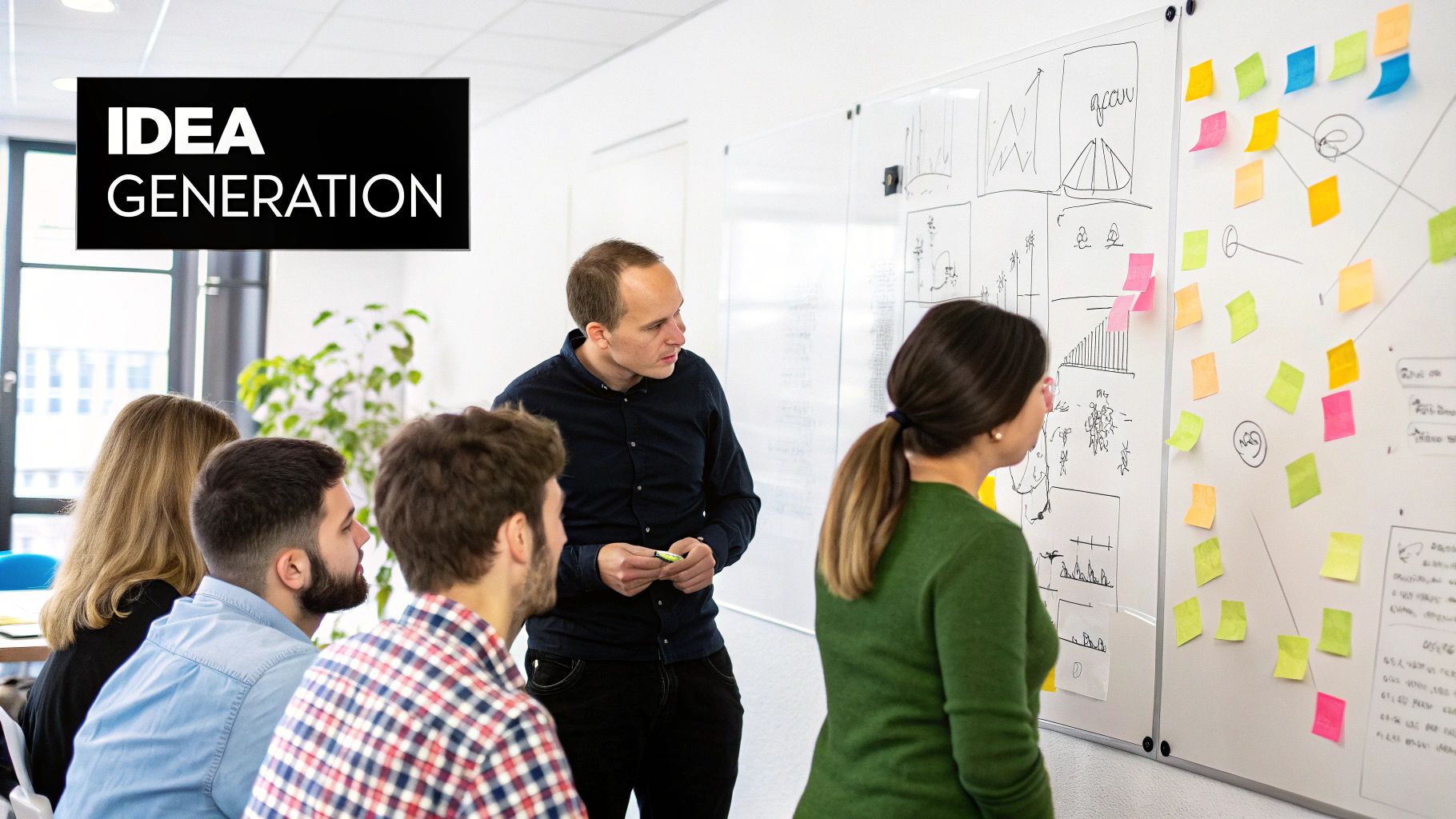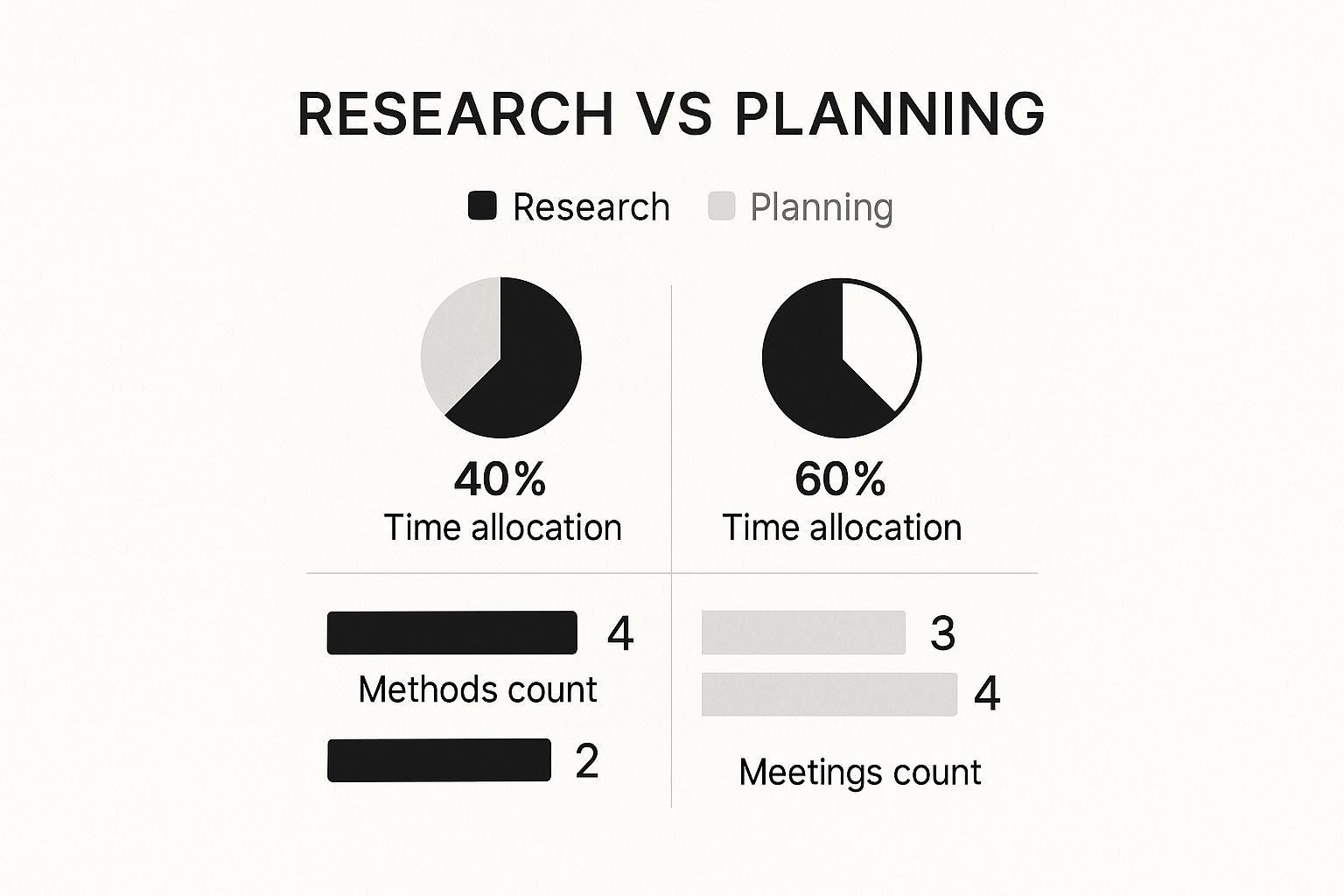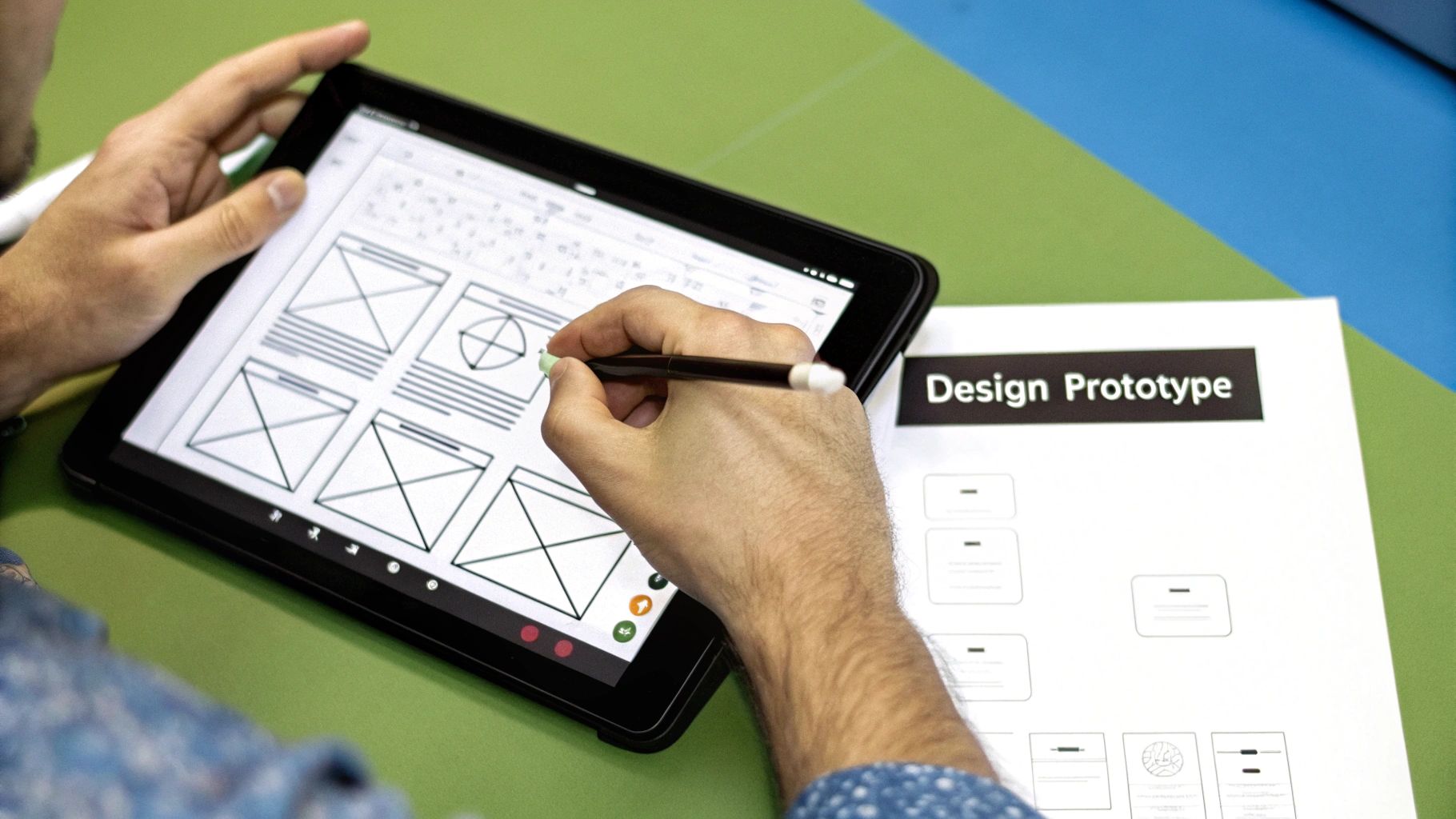Building Your Creative Project Workflow Foundation That Actually Works

A successful creative project relies on a strong foundation. This foundation is your creative project workflow, the structured path your team follows from initial idea to finished product. Think of it as the blueprint guiding your creative journey. Without a solid workflow, even the most innovative ideas can become lost in a sea of revisions, missed deadlines, and team frustrations.
Defining Clear Project Phases
Building a robust workflow starts with defining clear project phases. These phases usually include ideation, production, and post-production. Within each phase, more specific stages should be outlined. For instance, ideation could involve brainstorming and concept development. Production might encompass design, copywriting, and revisions. This granular approach allows for better task management and progress tracking.
Establishing Defined Roles and Responsibilities
A strong creative project workflow relies heavily on clearly defined roles and responsibilities. Each team member needs to understand their individual contributions and reporting structure. This clarity prevents confusion, eliminates redundant work, and promotes accountability. It means defining who owns each stage of the creative process, from brainstorming to final approval. Who leads the brainstorming sessions? Who ensures brand consistency in the designs?
Addressing common workflow challenges depends on this clarity. Research shows that 19% of industry leaders cite insufficient resources and tools as major obstacles. 51% grapple with time constraints, and 21% face unrealistic deadlines. More detailed statistics can be found here: Agency Report. Clear roles and well-defined processes can help mitigate these issues.
Conducting Effective Discovery Sessions
Detailed planning should always begin with a thorough discovery session. This involves gathering crucial information from stakeholders, such as project goals, target audience, budget, and timeline. A helpful resource on this topic is: How to Master the Creative Brief. A comprehensive discovery session can help prevent scope creep, a common problem that can derail projects. Understanding expectations from the start allows for a realistic roadmap and keeps the project on track.
Balancing Structure with Flexibility
While structure is essential, a creative workflow shouldn't stifle creativity. The most effective workflows balance structure with flexibility. They provide a framework while still allowing room for inspiration and innovation. This could mean incorporating regular feedback loops, promoting open communication, and fostering a culture of experimentation. With a solid foundation in place, your team can focus on what matters most: creating exceptional work.
Essential Tools That Transform Creative Workflow Management

The infographic above offers a compelling visual comparison of the Research and Planning stages in creative projects. It breaks down the time spent, methods used, and meeting frequency for each. Interestingly, Planning represents 60% of the project timeline, while Research accounts for 40%.
However, Planning utilizes fewer methods but involves more meetings. This clearly emphasizes the vital role of strong planning and communication in successful project completion.
Choosing the right creative project management software is key for team productivity and impactful results. The demand for smoother workflows is fueling rapid growth in this software market. The global market is projected to expand significantly through 2033. This highlights the increasing importance of specialized software in effectively managing creative work. Learn more about this growing market: Creative Project Management Software Market Report.
Navigating the Software Landscape
Selecting the best tools for your team can be daunting. Focusing on your specific needs and desired features simplifies the process. Consider options like Monday.com for its visual project boards and collaborative tools, Asana for task management and progress tracking, or Adobe Creative Cloud for its renowned design software.
To help you make the best decision for your team, we've compiled a comparison of these leading tools:
To help you evaluate the options, let’s compare some popular choices:
| Tool Name | Key Features | Team Size | Pricing Range | Best For |
|---|---|---|---|---|
| Monday.com | Visual project boards, collaborative features | All | Varies by plan | Visual project management, team collaboration |
| Asana | Task management, progress tracking | All | Varies by plan | Task-oriented teams, progress monitoring |
| Adobe Creative Cloud | Industry-standard design software | All | Varies by plan | Creative professionals, design-focused projects |
This table provides a quick overview of the strengths of each platform. Remember to explore each tool further to see which best aligns with your unique workflow.
Key Considerations for Tool Selection
Implementing any new software requires careful consideration. Look beyond the marketing and think about your team's practical needs:
- Integration Requirements: Seamless integration with existing software is crucial for minimizing disruptions and preventing information silos.
- Scalability: Choosing a scalable solution ensures the tool can adapt to your team's growth and evolving project requirements, avoiding future software migrations.
- User-Friendliness: An intuitive interface and ease of use are essential for maximizing user adoption and achieving a strong return on investment.
Addressing Real-World Creative Challenges
Specific tools offer solutions to everyday creative challenges:
- Version Control: Tools like Adobe Creative Cloud provide built-in version history and cloud storage, minimizing file loss and confusion.
- Client Changes: Platforms such as Monday.com and Asana streamline communication and feedback tracking, ensuring client changes are handled efficiently.
- Asset Management: A dedicated digital asset management (DAM) system can effectively organize, manage access to, and control versions of your creative assets.
Practical Implementation Strategies
A smooth software rollout requires strategic planning:
- Phased Rollout: Introduce the software gradually, starting with a pilot group to gather feedback before a full-scale implementation. This prevents overwhelming your team.
- Training and Support: Comprehensive training and ongoing support empower your team to fully utilize the software's features and minimize frustration.
- Ongoing Evaluation: Continuously evaluate the software's performance and collect team feedback to make adjustments and ensure long-term effectiveness.
Mastering Team Collaboration Without Killing Creativity

Collaboration is key for successful creative projects. But sometimes, teamwork can feel stifling. How can teams work together effectively while keeping individual creativity alive? The solution lies in strong communication, thoughtful feedback, and structured meetings. These elements ensure everyone is on the same page without sacrificing individual expression.
Effective Communication Strategies
Open communication is the foundation of any successful collaboration. It's more than just talking; it's about active listening, understanding diverse perspectives, and agreeing on communication methods that work for the entire team. This is especially important for teams with a mix of personalities.
Some team members may excel in brainstorming sessions, while others prefer communicating their ideas in writing. Recognizing and accommodating these differences creates a more inclusive and productive work environment.
Feedback That Fuels Creativity
Feedback is essential to the creative process, but it can be tricky. If done poorly, feedback can crush creativity and lead to bland results. However, constructive feedback, delivered respectfully and focused on improvement, can elevate a project.
This means focusing on the project goals and offering specific, actionable suggestions instead of general critiques. Clear feedback channels and timelines prevent confusion and keep the project on track.
Meetings That Spark, Not Stifle
Meetings often have a negative reputation, and often for good reason. Many creative meetings become unproductive wastes of time. But, with the right structure, meetings can be invaluable for collaboration and generating new ideas.
High-performing creative teams use meetings strategically, with clear agendas and defined outcomes. They might begin with a brainstorming session, then move to a critique of existing work, and finish with actionable next steps. This targeted approach ensures meetings contribute to the project's success.
In recent years, collaboration within creative projects has become increasingly important. Creative teams are now working more closely with other departments, like marketing and sales, to ensure alignment with overall business goals and reach target audiences. By 2025, this integrated approach became a hallmark of successful creative projects. Explore this topic further: Nail Your Creative Production Workflows. You might also be interested in: How to Master Creative Project Management.
Remote Collaboration and Shared Understanding
With the rise of remote work, creative teams need strategies for maintaining spontaneity and shared understanding across distances. This involves using virtual brainstorming tools, implementing effective asset sharing systems like Dropbox to avoid version control issues, and establishing review processes that respect both the creative vision and business requirements.
This ensures even distributed teams can collaborate effectively and contribute to a cohesive project. The key is to create a shared sense of purpose and build a culture of trust, regardless of location.
Optimizing Creative Process Stages For Maximum Impact
Stop thinking of creative projects as unpredictable mysteries. For consistent, outstanding results, you need a well-defined and optimized creative project workflow. This means breaking the creative process into distinct, manageable stages.
This approach improves the management of resources, timelines, and creative energy. It allows for better control and predictability in your creative endeavors.
Structuring Ideation for Breakthrough Thinking
Ideation, the first phase of any creative project, sets the stage for everything that follows. Well-structured ideation sessions with clearly defined goals and timeframes can encourage diverse thinking and lead to innovative solutions.
Brainstorming, mind mapping, and mood boarding are valuable techniques to generate a high volume of ideas quickly. This initial burst of creativity forms the foundation of your project.
Establishing Iteration Cycles That Work
The next important stage focuses on refining the initial sparks of inspiration. Establishing clear iteration cycles is crucial for preventing endless revisions and keeping projects moving forward.
This may involve regular feedback loops and developing prototypes for testing and improvement at each stage. This iterative process helps refine ideas and avoids getting stuck in endless revisions.
Quality Checkpoints: Maintaining Standards and Deadlines
Quality checkpoints, strategically placed throughout the creative project workflow, ensure alignment with expectations and standards. These checkpoints aren't designed to stifle creativity, but rather to catch potential problems early.
This proactive approach helps avoid costly rework later in the project. Careful monitoring helps maintain high quality while keeping deadlines in sight.
Managing Multiple Projects and Balancing Creative Exploration
Many creative professionals juggle multiple projects at once. This requires skillful management to avoid letting anything slip. Prioritization and efficient scheduling are essential.
Techniques like time blocking and task management software can be incredibly helpful for maintaining focus and staying organized. For more on optimizing creative operations, see our guide on How to master Creative Operations Management. Finding a balance between structured progress and creative exploration is key.
Consistent Output Quality Across Teams
Maintaining consistent output quality, particularly across different team members, can be challenging. Establishing clear style guides and brand guidelines, as well as a shared understanding of project goals, helps unify the team's efforts.
Regular communication and feedback sessions ensure everyone stays on the same page and produces work that meets the required high standards. This fosters a cohesive creative environment.
Identifying Bottlenecks and Streamlining Approvals
Bottlenecks, like slow approval processes, can derail even the most promising projects. Regular workflow audits help identify these pain points.
Streamlining these processes through clear communication channels and decision-making hierarchies keeps projects on track. This removes unnecessary delays and frustrations, creating systems that allow for both structured progress and those brilliant "aha!" moments.
To help visualize this process, let's examine a breakdown of each stage:
Creative Process Optimization Stages
| Stage | Duration | Key Activities | Common Bottlenecks | Optimization Tips |
|---|---|---|---|---|
| Ideation | Variable | Brainstorming, Mind Mapping, Mood Boarding | Lack of focus, Too many ideas, Fear of judgment | Set clear goals, Timeboxing, Encourage diverse perspectives |
| Concept Development | Variable | Refining ideas, Prototyping | Scope creep, Lack of client input, Unrealistic expectations | Define clear deliverables, Regular client communication, Iterate based on feedback |
| Production | Variable | Design, Copywriting, Development | Communication breakdowns, Technical difficulties | Use project management tools, Establish clear communication protocols |
| Revision & Feedback | Variable | Client review, Team feedback, Incorporating changes | Unclear feedback, Too many revisions | Use online proofing tools, Set clear feedback guidelines |
| Final Approval | Variable | Client sign-off | Delays in client response, Last-minute changes | Set clear deadlines, Establish escalation procedures |
This table provides a clear overview of the creative process, broken down into manageable stages, highlighting key activities, potential bottlenecks, and optimization tips. By focusing on each stage, teams can significantly improve the efficiency and impact of their creative work.
Managing Creative Timelines Without Sacrificing Quality

Creative projects often face timeline challenges. However, many delays can be avoided with a solid creative project workflow and effective timeline management. This section explores creating realistic schedules, anticipating roadblocks, and maintaining client confidence.
Creating Realistic Project Schedules
Accurate schedules are the foundation of successful creative projects. These schedules need to be more than just deadlines. They should account for the realities of creative work, like iterations, client feedback, and revisions. This involves adding buffer time to your timelines.
For example, if a design task is estimated to take two days, allocate three. This extra time provides flexibility and reduces the pressure of last-minute changes.
Breaking Down Complex Projects into Manageable Milestones
Large creative projects can be daunting. Breaking them down into smaller milestones creates a sense of accomplishment and simplifies tracking. Each milestone should have specific deliverables and a deadline.
This approach makes complex projects more manageable. It also helps identify potential delays early on. Creative Project Management Software can be helpful for managing these milestones.
Setting Up Early Warning Systems for Potential Delays
Even with careful planning, delays can occur. Early warning systems help identify potential problems before they become major issues. Regular team check-ins, progress reports, and tracking key performance indicators (KPIs) offer valuable insights.
For instance, if a team member consistently misses deadlines on small tasks, it might signal a larger problem that needs attention. This proactive approach minimizes disruptions and allows for adjustments.
Communicating Progress Effectively
Open communication builds client trust, especially when deadlines are tight. Regular updates, progress reports, and clear communication about potential delays strengthen client relationships. Proactive communication prevents surprises and addresses concerns effectively.
Visual tools like Gantt charts or Kanban boards can give clients a clear picture of project status and build confidence in your ability to deliver.
Handling Scope Changes Gracefully
Scope changes are common in creative projects. A defined process for evaluating and incorporating these changes is essential. This includes assessing the impact of changes on the project, adjusting the timeline and budget, and communicating transparently with the client.
Effective scope change management prevents project derailment and maintains positive client relationships.
Managing Client Expectations Without Overpromising
Managing client expectations requires balance. While enthusiasm is important, overpromising can damage trust. Setting realistic expectations from the beginning, communicating openly about potential challenges, and delivering on commitments builds strong relationships.
Honesty and transparency foster trust and establish you as a reliable partner.
Maintaining Team Morale During Crunch Times
Tight deadlines can impact team morale and creativity. Prioritizing team well-being, providing support, and celebrating milestones helps maintain motivation.
This focus on well-being creates a positive work environment and ensures high-quality output, even during demanding times. This proactive approach to workflows, from timelines to team dynamics, leads to better project outcomes and client relationships.
Measuring Success and Driving Continuous Improvement
Moving beyond superficial metrics like social media engagement is crucial for gauging true creative success. This section focuses on establishing Key Performance Indicators (KPIs) that balance creative excellence with tangible business outcomes. These KPIs can range from meaningful productivity measures to client satisfaction scores that predict long-term partnerships.
Establishing Meaningful KPIs
Effective KPIs should reflect both the creative quality and the business impact of your work. Consider these examples:
-
Project Completion Rate: This metric tracks how many projects are finished on time and within budget, providing a clear picture of team efficiency.
-
Client Satisfaction Score: Regularly surveying clients offers valuable insights into their happiness and identifies areas for improvement in your creative project workflow.
-
Return on Investment (ROI): Tracking the financial return of creative projects demonstrates their value and justifies future investments. A successful advertising campaign, for instance, could be measured by the number of leads generated or sales achieved.
Implementing Workflow Audits and Gathering Actionable Feedback
Regular workflow audits help identify areas for improvement. Think of a workflow audit as a diagnostic check for your creative process. It involves analyzing each step of the workflow to pinpoint bottlenecks and inefficiencies.
For example, if projects are consistently delayed during the approval stage, it suggests a need to streamline the approval process. Gathering feedback from both team members and clients provides valuable insights into problem areas and opportunities for optimization. This feedback should be specific and actionable, not simply general observations. “The approval process takes too long” is less helpful than “We need clearer guidelines for who approves what and by when.”
Identifying Workflow Strengths and Weaknesses
Analyzing collected data from audits and feedback reveals patterns indicating your creative project workflow’s strengths and weaknesses. Perhaps your ideation process consistently generates innovative concepts, but your production phase struggles with bottlenecks. This identification lets you concentrate improvement efforts where they are most needed.
You might be interested in: How to Master Creative Workflow Management. This resource explores practical strategies for optimizing workflows.
Conducting Effective Project Retrospectives
Project retrospectives, held after project completion, encourage learning and improvement. These meetings offer a structured setting for team members to reflect on what went well, what could be improved, and what actions to take for future projects.
Effective retrospectives involve honest discussion, constructive feedback, and actionable next steps. Suppose a team realizes that unclear communication caused delays in a recent project. Their next step might be to implement a new communication protocol.
Documenting Lessons Learned and Implementing Improvements
Documenting lessons learned from project retrospectives creates a valuable knowledge base for future projects. This documentation shouldn't be archived and forgotten. It should be readily accessible and actively used by the team.
For example, imagine a team documents a successful new brainstorming technique. Making this information easily available ensures other teams can benefit from their experience. This continuous learning and improvement cycle is vital for long-term success. Effective creative leaders balance quantitative data with qualitative assessments, ensuring efficiency improvements never compromise innovation.
Ready to enhance your creative workflow and connect with top local talent? Visit Creativize to discover how we can empower your creative projects and help you achieve exceptional results.

